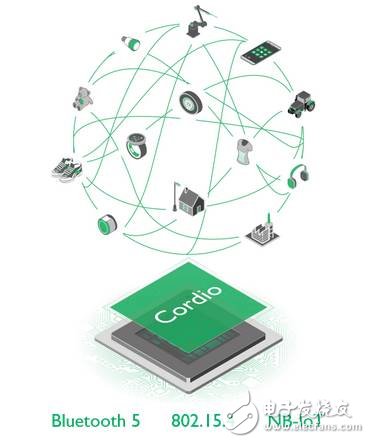In the age of the Internet of Everything, ARM's mission is to expand the entire IoT ecosystem by providing a secure architecture that supports endpoint devices. Recently, ARM expert Chet Babla concluded a series of meetings and exchanges with global chipmakers, infrastructure providers, telecom operators, and end-users employing LPWA technology. How does he view the six common perspectives in the cellular IoT technology industry? Let’s dive into the details.


**Perspective 1:** Cat-M1 and NB-IoT are struggling to gain market traction, but non-cellular LPWA technology will dominate.

Numerous articles claim that Cat-M1 (correctly named "LTE-M") and NB-IoT are gaining adoption slower than expected, while non-cellular technologies like Sigfox and LoRa are becoming de facto standards for LPWA deployment. Several factors come into play:
First, any LPWA technology—whether cellular-based, carrier-deployed, or enterprise-deployed—must demonstrate it can solve real-world problems in a commercially viable manner.
Second, IoT applications are incredibly diverse, meaning different technologies are needed to meet their varied requirements. The "one-size-fits-all" approach is not cost-effective for all applications.
Third, different LPWA technologies won't achieve normative maturity simultaneously. NB-IoT achieved stability with the 3GPP Release 13 specification in March 2017. Hence, various LPWAN technologies have different deployment schedules, maturity timelines, and rhythms.
Chet Babla believes the tech industry is overly optimistic about the speed of wireless technology adoption, but in the long run, final shipments are typically lower than expected. The ultimate commercial success lies in **open wireless standards**. Examples include Wi-Fi, Bluetooth, and 3G, all of which succeeded due to open standards. Initially, these standards lacked commercial appeal, but once ecosystems developed and use cases became clear, success followed.
He also believes that any open LPWA technology needs over 100 million individual node deployments to achieve a self-sustaining critical market size, enabling economies of scale. While this isn't a perfect analogy to digital ecosystems like Spotify, which need at least 1 million active users daily to reach critical mass, the concept of achieving profitability through scale applies similarly to LPWA technologies. The 100 million deployment node threshold aligns with the experiences of other wireless technologies.
During his recent trip to China, Chet Babla met with Chinese operators, chipmakers, and end-users leveraging LPWA technology. He also attended the GSMA Shanghai Mobile World Congress. Clearly, NB-IoT and Cat-M1 are solidifying their roles as key LPWA technologies, while LoRa enjoys early commercial appeal. GSMA reported at MWC Shanghai that 37 operators and 27 suppliers globally now support cellular LPWA, with 56 active pilot projects covering applications like utility meters, parking, shared bikes, and security panels. Currently, nine commercial Cat-M1 or NB-IoT networks exist worldwide, supported by seven major carriers.
While these statistics and recent industry announcements are promising, Chet Babla is more convinced by China's Ministry of Industry and Information Technology's recent policy. By the end of 2017, 400,000 cellular base stations will support NB-IoT services, aiming for 1.5 million base stations by 2020. These infrastructure numbers translate to 20 million and 600 million NB-IoT nodes by the Ministry of Industry and Information Technology of China in 2020.

**Perspective 2:** NB-IoT is competing with Cat-M1.

Chet Babla sees this as "fake news" meant to stir controversy, akin to the VH vs. Betamax debates of the past. In reality, these two technologies have distinct characteristics and don't overlap.
NB-IoT is ideal for simple sensor node applications where the connected "things" are typically stationary and transmit no more than tens of bytes of data per day. Applications like smart parking, smart meters, agricultural sensors, and smart municipal lighting exemplify NB-IoT use cases.
Conversely, Cat-M1 is better suited for IoT applications requiring higher data rates, mobility, or voice, such as digital signage, real-time asset tracking, and alarm panels. While there are overlapping applications, the two technologies are highly complementary, as Chet Babla learned from discussions with operators and infrastructure providers.
Thus, to address all IoT applications, single-mode and multi-mode cellular LPWA solutions, along with non-cellular LPWA solutions, will coexist.


**Perspective 3:** NB-IoT has no cost advantage over Cat-M1.

Most available (or under development) cellular LPWA chip solutions derive from existing higher-specification LTE modem technology (Cat-1, Cat-4), rather than being designed specifically for Cat-M1 or NB-IoT. Additionally, Cat-M1 supports enhanced functionalities compared to NB-IoT (higher data rates, voice, and mobility), which require greater processing power and memory than NB-IoT.
In some industries, it's said that when NB-IoT functionality is included in a Cat-M1 solution, NB-IoT is essentially "free" due to minimal added chip area. This might hold true in some cases, but conversely, **NB-IoT is likely a more cost-effective standard than Cat-M1 because of its lower processing requirements and smaller subset of functions, leading to smaller silicon wafer area**.

**Point 4:** NB-IoT suffers from interoperability issues between equipment and infrastructure.

Historically, interoperability issues arise from natural timing mismatches in software development cycles between equipment and infrastructure vendors. This mismatch surfaced when non-backward compatible change requests (CRs) were introduced into the March 13, 2017, 3GPP release specification update. **This issue will resolve itself in the coming months as software delivery from both sides synchronizes**. This is a great example of how many partners collaborate to ensure global interoperability, not indicative of any lack of robustness in the NB-IoT standard.
By the way, inconsistencies in supplier development cycles for newly introduced or updated standards aren't unique to cellular LPWA technology. A major infrastructure provider told us this is a natural phenomenon in the evolution of all new cellular standards and cited recent interoperability issues related to LTE Class 16 smartphone platform testing, which haven't made headlines (because industry insiders understand this is a natural occurrence in complex multi-vendor tech development).

**Point 5:** Cellular LPWA solutions can't run on a battery for 10 years.

Are Cat-M1 and NB-IoT energy-efficient enough to last 10 years? A 3GPP Technical Note (TR45.820) outlines a methodology for calculating Cat-M1 and NB-IoT battery life, considering receiver, transmitter standby, and deep sleep power consumption under certain assumptions (power amplifier efficiency, 5Whr battery capacity).
The analysis also considers the impact of three different coverage schemes ("excellent," "typical," and "poor") and the requirements of sample IoT applications (sensor data update frequency and volume).
3GPP analysis shows that in "good" coverage and low sensor update rate scenarios, nodes rarely send or retransmit data, so battery life is determined by standby and deep sleep power consumption. Under these conditions, NB-IoT can theoretically last over 10 years on a 5Whr battery.
Conversely, if nodes are deployed in "poor" coverage scenarios (deep indoors or at the cell edge) or if applications require frequent sensor data updates, the receiving and transmitting power consumption becomes the primary battery drain.
For reference, typical batteries for these applications might be AA or D-type lithium batteries, and commercially available batteries can easily exceed the 5Whr assumption by 3GPP. A small button lithium "battery" could technically be used, but about a dozen NB-IoT or Cat-M1 devices connected in parallel would be needed to provide the required peak transfer current. Note that the 3GPP calculation doesn't account for self-discharge (approximately 1% per year for lithium batteries) or temperature effects (self-discharge doubles for every 10°C increase). These real-life battery effects will gradually degrade overall battery life. Interestingly, although NB-IoT is more efficient than Cat-M1 in some cases, this advantage diminishes in poor coverage scenarios.
In summary, **cellular LPWA technology can extend battery life beyond 10 years, but endurance calculations are multifactorial, and non-cellular LPWA technologies face similar limitations in poor coverage or high sensor update rate scenarios**. Since different LPWA technologies suit different application scenarios, a direct one-to-one comparison of battery life is somewhat simplistic.

**Point 6:** Cellular LPWA modules cannot cost less than $5.

If economies of scale are achieved, any technology can reduce costs. In the "traditional" cellular M2M market, 2G GPRS modules now cost less than $5. However, the cellular communications industry has been around for 25 years, with billions of 2G chipsets shipped, driving chip and module pricing to maturity. But the industry can't wait 25 years to benefit from the "IoT" feature of cellular connectivity. So Chet Babla believes that **vertical integration of the LPWA module supply chain is necessary to achieve revolutionary yet beneficial price leaps**.
Higher-specification 3G or LTE modules don't drive supply chain vertical integration because end applications like laptops, surveillance cameras, or car connections can often afford higher module prices. For LPWAN's aggressive price targets, Chet Babla thinks the chip and module gross margins, plus the need for external SIM components and RF front-end passive components, are areas the industry must focus on to achieve significant price reductions. Visionaries must step up to meet this challenge, and ARM is actively exploring ways to support innovators in its partnerships to achieve this goal.
Considering that 2G GPRS meets many key IoT application requirements (voice capability, mobility, and highly mature costs), why isn't it the best solution for LPWA technology? Two key reasons stand out: first, the 2G band is a highly valuable resource for operators and is being reallocated worldwide for higher data rates. Second, 2G technology's power consumption isn't as competitive as cellular LPWA, as cellular LPWA has dedicated power-saving and discontinuous reception modes.
**What insights does all this offer us?**
IoT isn't a single technology but refers to using the right technology to create a viable business model solving real-world problems. For the IoT industry, there's no one-size-fits-all networking solution, and we must accept and embrace this reality.
PAN, LAN, WAN, licensed, and unlicensed connection technologies all need to coexist and complement each other. Thus, stating that "my connection technology is the best" is not only incorrect but also misleading, disrupting the industry's progress toward promoting the ultimate vertical markets (utilities, agriculture, logistics, building management, insurance, etc.).
LPWA connectivity technology will undoubtedly play a crucial role in the broader IoT market, and ARM will continue to ensure secure, efficient processor and connectivity technology solutions to help build a broader IoT ecosystem. Click on **"Read the original"** to visit the ARM Cordio homepage for more information.

Dc To Ac Inverter,Dc Ac Pure Sine Wave Inverter,Dc 12 Volts Car Inverter,Dc Ac Power Inverter
GuangZhou HanFong New Energy Technology Co. , Ltd. , https://www.gzinverter.com